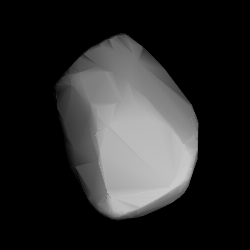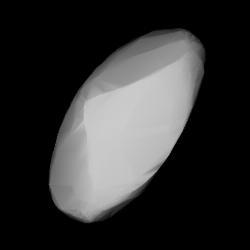Related Research Articles

1997 Leverrier is a stony Flora asteroid from the inner regions of the asteroid belt. It was discovered on 14 September 1963, by the Indiana Asteroid Program at Goethe Link Observatory near Brooklyn, Indiana, United States, and named after French mathematician Urbain Le Verrier. The asteroid has a rotation period of 6.8 hours and measures approximately 7 kilometers in diameter

1126 Otero, provisional designation 1929 AC, is a rare-type Florian asteroid from the inner regions of the asteroid belt, approximately 10 kilometers in diameter. It was discovered on 11 January 1929, by German astronomer Karl Reinmuth at Heidelberg Observatory in southwest Germany. It was named after Spanish courtesan Carolina Otero.
1131 Porzia, provisional designation 1929 RO, is a stony asteroid and sizable Mars-crosser from the innermost regions of the asteroid belt, approximately 7 kilometers in diameter. It was discovered on 10 September 1929, by German astronomer Karl Reinmuth at the Heidelberg Observatory in southwest Germany. The asteroid was named after Porcia wife of Brutus, who assassinated Julius Caesar.
1138 Attica, provisional designation 1929 WF, is an asteroid from the outer region of the asteroid belt, approximately 24 kilometers in diameter. It was discovered on 22 November 1929, by German astronomer Karl Reinmuth at Heidelberg Observatory in southwest Germany. It was named after the Attica Province in Greece.
1139 Atami, provisional designation 1929 XE, is a stony asteroid and sizable Mars-crosser, as well as a synchronous binary system near the innermost region of the asteroid belt, approximately 9 kilometers in diameter. It was discovered on 1 December 1929, by Japanese astronomers Okuro Oikawa and Kazuo Kubokawa at the Tokyo Astronomical Observatory near Tokyo. It was named after the Japanese city of Atami. It has the lowest Minimum orbit intersection distance (MOID) to Mars of any asteroid as large as it, its orbit intersecting only 0.03 astronomical units from the planet.
1157 Arabia, provisional designation 1929 QC, is an asteroid from the outer regions of the asteroid belt, approximately 29 kilometers in diameter. Astronomer Karl Reinmuth discovered it at the Heidelberg Observatory in southwest Germany on 31 August 1929. The asteroid was named for the Arabian Peninsula.
2751 Campbell, provisional designation 1962 RP, is a stony Nysian asteroid from the inner regions of the asteroid belt, approximately 6 kilometers in diameter.
1394 Algoa, provisional designation 1936 LK, is a stony asteroid from the inner regions of the asteroid belt, approximately 14 kilometers in diameter. It was discovered on 12 June 1936, by English-born South-African astronomer Cyril Jackson at Union Observatory in Johannesburg, South Africa. The asteroid was named after the historical Algoa Bay.

2839 Annette is a bright Flora asteroid from the inner regions of the asteroid belt. It was discovered on 5 October 1929, by American astronomer Clyde Tombaugh at Lowell Observatory during his search for Pluto. The presumed S-type asteroid has a rotation period of 10.5 hours and measures approximately 5 kilometers in diameter. It was named after the discoverer's daughter.
39890 Bobstephens, provisional designation 1998 FA3, is a stony asteroid from the middle region of the asteroid belt, approximately 2 kilometers in diameter. The asteroid was discovered on 23 March 1998, by Czech astronomer Petr Pravec at Ondřejov Observatory near Prague in the Czech Republic. It was named for American astronomer Robert Stephens.
1543 Bourgeois, provisional designation 1941 SJ, is a stony asteroid from the central asteroid belt's background population, approximately 12 kilometers in diameter. It was discovered on 21 September 1941, by astronomer Eugène Delporte at the Royal Observatory of Belgium in Uccle. The asteroid was named after Belgian astronomer Paul Bourgeois.
1818 Brahms, provisional designation 1939 PE, is an asteroid from the inner regions of the asteroid belt, approximately 6 kilometers in diameter. It was discovered on 15 August 1939, by German astronomer Karl Reinmuth at Heidelberg Observatory in southern Germany. The asteroid was named after composer Johannes Brahms.
24101 Cassini, provisional designation 1999 VA9, is an eccentric background asteroid from the middle region of the asteroid belt, approximately 7 kilometers in diameter. It was discovered on 9 November 1999, by American amateur astronomer Charles Juels at the Fountain Hills Observatory (678) in Arizona, United States. It was named after Italian–French astronomer Giovanni Cassini.

1555 Dejan, provisional designation 1941 SA, is an asteroid from the background population of the central regions of the asteroid belt, approximately 22 kilometers in diameter. It was discovered on 15 September 1941, by Belgian astronomer Fernand Rigaux at the Royal Observatory of Belgium in Uccle. The asteroid was named after Dejan Đurković, son of Serbian astronomer Petar Đurković.
6141 Durda, provisional designation 1992 YC3 is a stony Hungaria asteroid, classified as slow rotator and Mars-crosser from the innermost region of the asteroid belt, approximately 3.2 kilometers in diameter. It was discovered on 26 December 1992, by Spacewatch at Kitt Peak National Observatory in Arizona, United States.
1205 Ebella, provisional designation 1931 TB1, is a relatively eccentric asteroid from the central regions of the asteroid belt, approximately 5.5 kilometers in diameter. It was discovered by astronomer Karl Reinmuth at Heidelberg Observatory on 6 October 1931. The asteroid was named after German astronomer Martin Ebell.
2754 Efimov, provisionally named 1966 PD, is a stony asteroid and binary system from the inner regions of the asteroid belt, approximately 5 kilometers in diameter. It was discovered on 13 August 1966, by Russian astronomer Tamara Smirnova at the Crimean Astrophysical Observatory in Nauchnyj, on the Crimean peninsula. The asteroid was named after Russian aviator Mikhail Efimov.
1842 Hynek, provisional designation 1972 AA, is a stony Florian asteroid from the inner regions of the asteroid belt, approximately 8 kilometers in diameter.
1990 Pilcher, provisional designation 1956 EE, is a stony background asteroid from the Florian region of the inner asteroid belt, approximately 7 kilometers in diameter. It was discovered on 9 March 1956, by German astronomer Karl Reinmuth at the Heidelberg-Königstuhl State Observatory in Heidelberg, Germany. In 1982, it was named by the MPC for American physicist and photometrist Frederick Pilcher. The S-type asteroid has a short rotation period of 2.8 hours.
2623 Zech, provisional designation A919 SA, is a stony binary asteroid from the inner regions of the asteroid belt, approximately 6.5 kilometers in diameter. It was discovered on 22 September 1919, by German astronomer Karl Reinmuth at Heidelberg Observatory in southwest Germany. It was named after German ARI astronomer Gert Zech.
References
- 1 2 3 4 5 6 7 8 "JPL Small-Body Database Browser: 1134 Kepler (1929 SA)" (2016-05-10 last obs.). Jet Propulsion Laboratory . Retrieved 8 February 2017.
- 1 2 3 4 Schmadel, Lutz D. (2007). "(1134) Kepler". Dictionary of Minor Planet Names – (1134) Kepler. Springer Berlin Heidelberg. p. 96. doi:10.1007/978-3-540-29925-7_1135. ISBN 978-3-540-00238-3.
- 1 2 3 "1134 Kepler (1929 SA)". Minor Planet Center. Retrieved 8 February 2017.
- 1 2 3 "Absolute Magnitude (H)". NASA/JPL. Archived from the original on 2 March 2001. Retrieved 8 February 2017.
- 1 2 "(1134) Kepler lightcurve". CdR-CdL. Retrieved 9 December 2017.
- ↑ "LCDB Data for (1134) Kepler". Asteroid Lightcurve Database (LCDB). Retrieved 8 February 2017.
- ↑ "LCDB: Summary Table Query Form". Asteroid Lightcurve Database (LCDB). Retrieved 8 February 2017.